2023 SUBARU BRZ seats
[x] Cancel search: seatsPage 44 of 432

Rear Seats
38▼Folding down the rear seatbackLock release button
Lock release strapUnlock the seatback by performing either
of the following procedures and then fold
the seatback down.
Push the right and left lock release
buttons.
Pull the right and left lock release
straps.
▼ Return the rear seatback
Lock release button
1) Unlocked
2) Locked
A) Unlocking marker in redTo return the seatback to its original posi-
tion, raise the seatba ck until it locks into
place and ensure that the unlocking
marker on the lock release button is no
longer visible.
102667102670
A
12
102671
WARNING
When you return the seatback to its
original position, check that the
unlocking marker is not visible.
Also, push the rear seatback and
then check that it is securely locked
in position by lightly pushing it
back and forth. If the seatback is
not securely fixed in place, the
seatback may suddenly fold down
in the event of sudden braking, or
objects may move out from the
trunk, which could cause serious
injury or death.
BRZ_U.book 38 ページ 2022年3月29日 火曜日 午後3時59分
Page 45 of 432
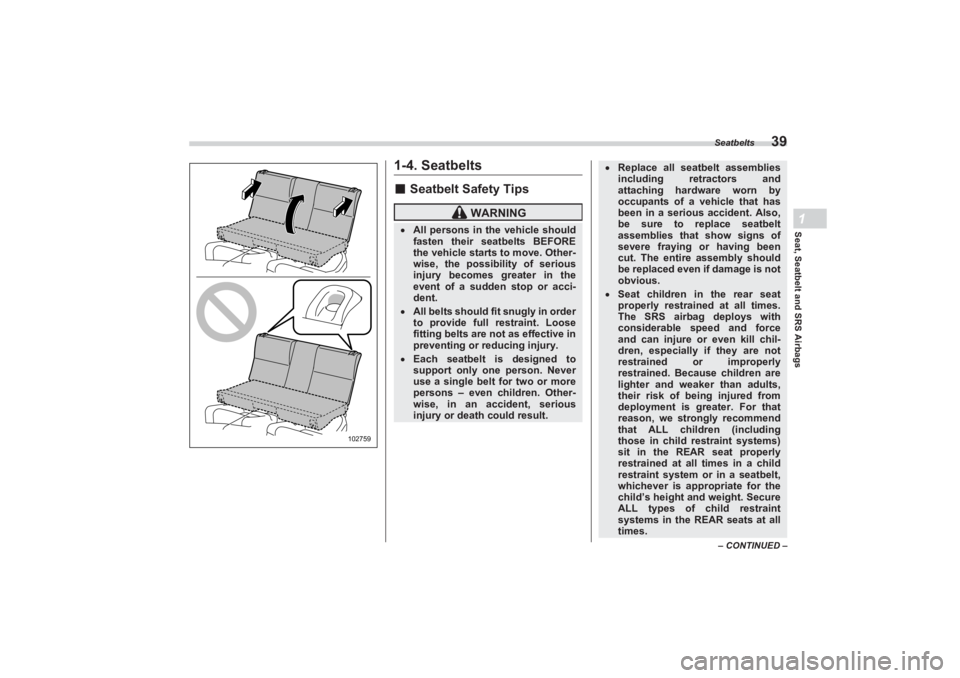
Seatbelts
39
Seat, Seatbelt and SRS Airbags1
– CONTINUED –
1-4. Seatbelts■Seatbelt Safety Tips
102759
WARNING
All persons in the vehicle should
fasten their seatbelts BEFORE
the vehicle starts to move. Other-
wise, the possibility of serious
injury becomes greater in the
event of a sudden stop or acci-
dent. All belts should fit snugly in order
to provide full restraint. Loose
fitting belts are not as effective in
preventing or reducing injury. Each seatbelt is designed to
support only one person. Never
use a single belt for two or more
persons – even children. Other-
wise, in an accident, serious
injury or death could result.
Replace all seatbelt assemblies
including retractors and
attaching hardware worn by
occupants of a vehicle that has
been in a serious accident. Also,
be sure to replace seatbelt
assemblies that show signs of
severe fraying or having been
cut. The entire assembly should
be replaced even if damage is not
obvious. Seat children in the rear seat
properly restrained at all times.
The SRS airbag deploys with
considerable speed and force
and can injure or even kill chil-
dren, especially if they are not
restrained or improperly
restrained. Because children are
lighter and weaker than adults,
their risk of being injured from
deployment is greater. For that
reason, we strongly recommend
that ALL children (including
those in child restraint systems)
sit in the REAR seat properly
restrained at all times in a child
restraint system or in a seatbelt,
whichever is appropriate for the
child’s height and weight. Secure
ALL types of child restraint
systems in the REAR seats at all
times.
BRZ_U.book 39 ページ 2022年3月29日 火曜日 午後3時59分
Page 47 of 432
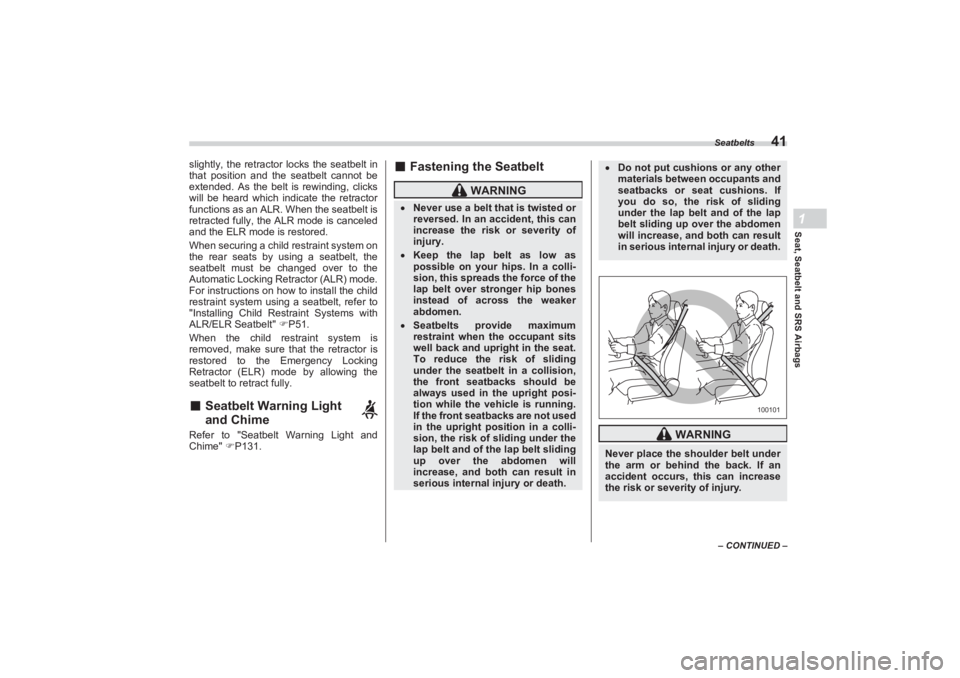
Seatbelts
41
Seat, Seatbelt and SRS Airbags1
– CONTINUED –
slightly, the retractor locks the seatbelt in
that position and the seatbelt cannot be
extended. As the belt is rewinding, clicks
will be heard which indicate the retractor
functions as an ALR. When the seatbelt is
retracted fully, the ALR mode is canceled
and the ELR mode is restored.
When securing a child restraint system on
the rear seats by using a seatbelt, the
seatbelt must be changed over to the
Automatic Locking Retractor (ALR) mode.
For instructions on how to install the child
restraint system using a seatbelt, refer to
"Installing Child Restraint Systems with
ALR/ELR Seatbelt" P51.
When the child restraint system is
removed, make sure that the retractor is
restored to the Emergency Locking
Retractor (ELR) mode by allowing the
seatbelt to retract fully.■ Seatbelt Warning Light
and Chime Refer to "Seatbelt Warning Light and
Chime" P131.
■ Fastening the Seatbelt
WARNING
Never use a belt that is twisted or
reversed. In an accident, this can
increase the risk or severity of
injury. Keep the lap belt as low as
possible on your hips. In a colli-
sion, this spreads the force of the
lap belt over stronger hip bones
instead of across the weaker
abdomen. Seatbelts provide maximum
restraint when the occupant sits
well back and upright in the seat.
To reduce the risk of sliding
under the seatbelt in a collision,
the front seatbacks should be
always used in the upright posi-
tion while the vehicle is running.
If the front seatbacks are not used
in the upright position in a colli-
sion, the risk of sliding under the
lap belt and of the lap belt sliding
up over the abdomen will
increase, and both can result in
serious internal injury or death.
Do not put cushions or any other
materials between occupants and
seatbacks or seat cushions. If
you do so, the risk of sliding
under the lap belt and of the lap
belt sliding up over the abdomen
will increase, and both can result
in serious internal injury or death.
WARNING
Never place the shoulder belt under
the arm or behind the back. If an
accident occurs, this can increase
the risk or severity of injury.
100101
BRZ_U.book 41 ページ 2022年3月29日 火曜日 午後3時59分
Page 48 of 432
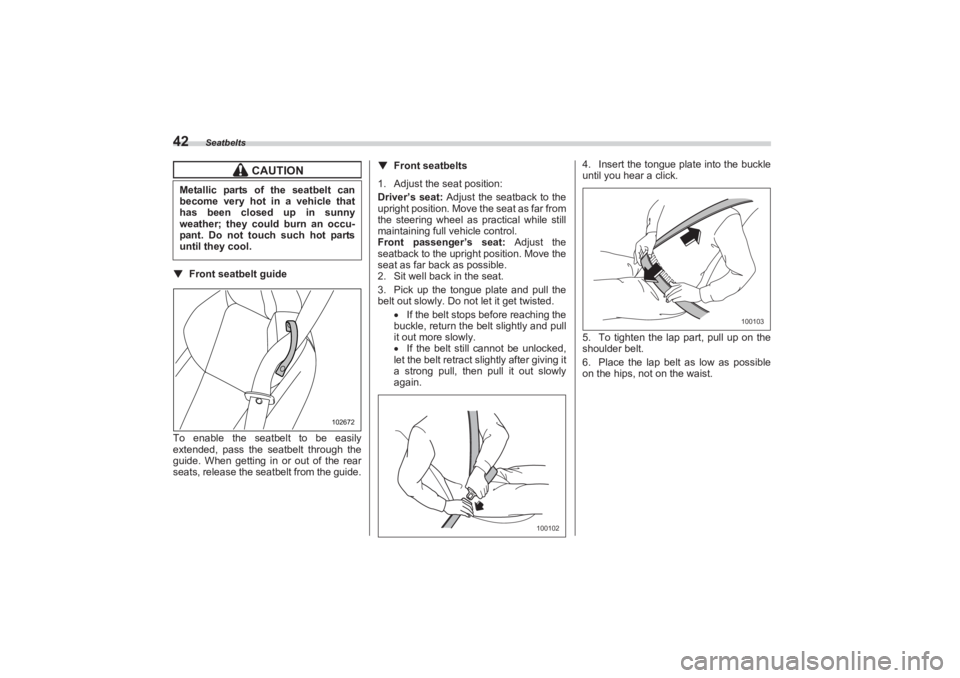
Seatbelts
42▼Front seatbelt guide
To enable the seatbelt to be easily
extended, pass the seatbelt through the
guide. When getting in or out of the rear
seats, release the seatbelt from the guide. ▼
Front seatbelts
1. Adjust the seat position:
Driver’s seat: Adjust the seatback to the
upright position. Move the seat as far from
the steering wheel as practical while still
maintaining full vehicle control.
Front passenger’s seat: Adjust the
seatback to the upright position. Move the
seat as far back as possible.
2. Sit well back in the seat.
3. Pick up the tongue plate and pull the
belt out slowly. Do not let it get twisted.
If the belt stops before reaching the
buckle, return the belt slightly and pull
it out more slowly.
If the belt still cannot be unlocked,
let the belt retract slightly after giving it
a strong pull, then pull it out slowly
again. 4. Insert the tongue plate into the buckle
until you hear a click.
5. To tighten the lap part, pull up on the
shoulder belt.
6. Place the lap belt as low as possible
on the hips, not on the waist.
CAUTION
Metallic parts of the seatbelt can
become very hot in a vehicle that
has been closed up in sunny
weather; they could burn an occu-
pant. Do not touch such hot parts
until they cool.
102672
100102
100103
BRZ_U.book 42 ページ 2022年3月29日 火曜日 午後3時59分
Page 52 of 432
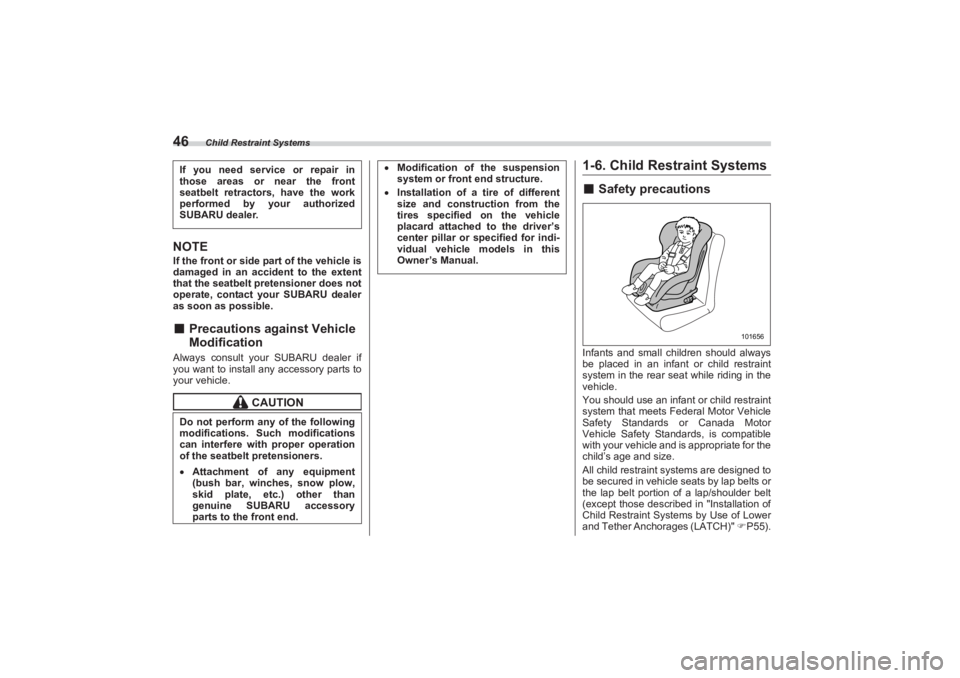
Child Restraint Systems
46NOTEIf the front or side part of the vehicle is
damaged in an accident to the extent
that the seatbelt pretensioner does not
operate, contact your SUBARU dealer
as soon as possible.■ Precautions against Vehicle
ModificationAlways consult your SUBARU dealer if
you want to install any accessory parts to
your vehicle.
1-6. Child Restraint Systems■ Safety precautionsInfants and small children should always
be placed in an infant or child restraint
system in the rear seat while riding in the
vehicle.
You should use an infant or child restraint
system that meets Federal Motor Vehicle
Safety Standards or Canada Motor
Vehicle Safety Standards, is compatible
with your vehicle and is appropriate for the
child’s age and size.
All child restraint systems are designed to
be secured in vehicle seats by lap belts or
the lap belt portion of a lap/shoulder belt
(except those described in "Installation of
Child Restraint Systems by Use of Lower
and Tether Anchorages (LATCH)" P55).
If you need service or repair in
those areas or near the front
seatbelt retractors, have the work
performed by your authorized
SUBARU dealer.
CAUTION
Do not perform any of the following
modifications. Such modifications
can interfere with proper operation
of the seatbelt pretensioners. Attachment of any equipment
(bush bar, winches, snow plow,
skid plate, etc.) other than
genuine SUBARU accessory
parts to the front end.
Modification of the suspension
system or front end structure. Installation of a tire of different
size and construction from the
tires specified on the vehicle
placard attached to the driver’s
center pillar or specified for indi-
vidual vehicle models in this
Owner’s Manual.
101656
BRZ_U.book 46 ページ 2022年3月29日 火曜日 午後3時59分
Page 55 of 432
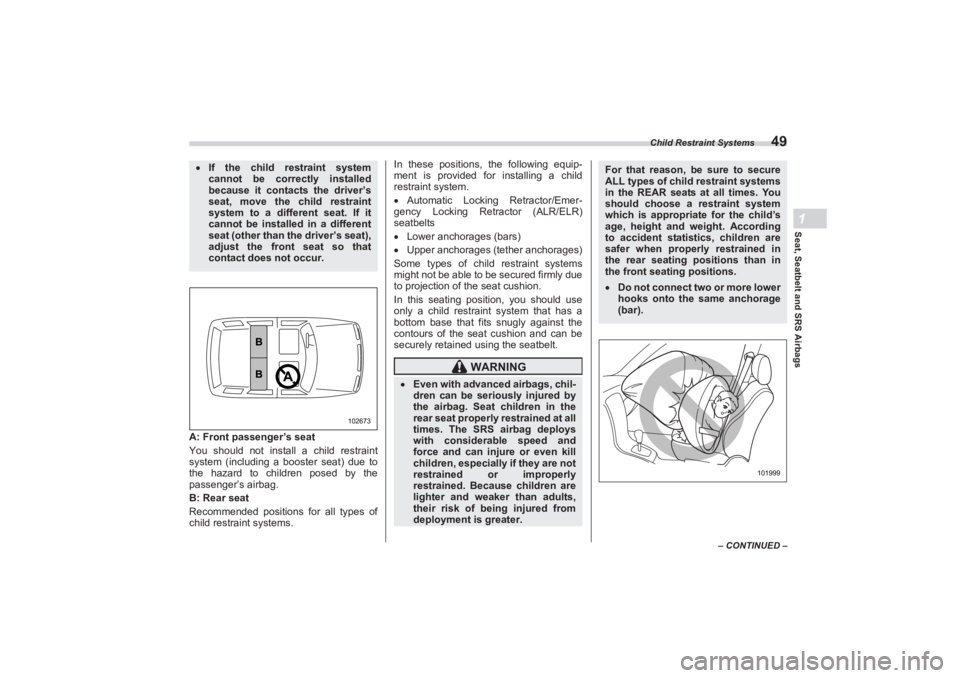
Child Restraint Systems
49
Seat, Seatbelt and SRS Airbags1
– CONTINUED –
A: Front passenger’s seat
You should not install a child restraint
system (including a bo oster seat) due to
the hazard to children posed by the
passenger’s airbag.
B: Rear seat
Recommended positions for all types of
child restraint systems. In these positions, the following equip-
ment is provided for installing a child
restraint system.
Automatic Locking Retractor/Emer-
gency Locking Retractor (ALR/ELR)
seatbelts
Lower anchorages (bars)
Upper anchorages (tether anchorages)
Some types of child restraint systems
might not be able to be secured firmly due
to projection of the seat cushion.
In this seating position, you should use
only a child restrain t system that has a
bottom base that fits snugly against the
contours of the seat cushion and can be
securely retained using the seatbelt. If the child restraint system
cannot be correctly installed
because it contacts the driver’s
seat, move the child restraint
system to a different seat. If it
cannot be installed in a different
seat (other than the driver’s seat),
adjust the front seat so that
contact does not occur.
102673
WARNING
Even with advanced airbags, chil-
dren can be seriously injured by
the airbag. Seat children in the
rear seat properly restrained at all
times. The SRS airbag deploys
with considerable speed and
force and can injure or even kill
children, especially if they are not
restrained or improperly
restrained. Because children are
lighter and weaker than adults,
their risk of being injured from
deployment is greater.
For that reason, be sure to secure
ALL types of child restraint systems
in the REAR seats at all times. You
should choose a restraint system
which is appropriate for the child’s
age, height and weight. According
to accident statistics, children are
safer when properly restrained in
the rear seating positions than in
the front seating positions. Do not connect tw o or more lower
hooks onto the same anchorage
(bar).
101999
BRZ_U.book 49 ページ 2022年3月29日 火曜日 午後3時59分
Page 61 of 432
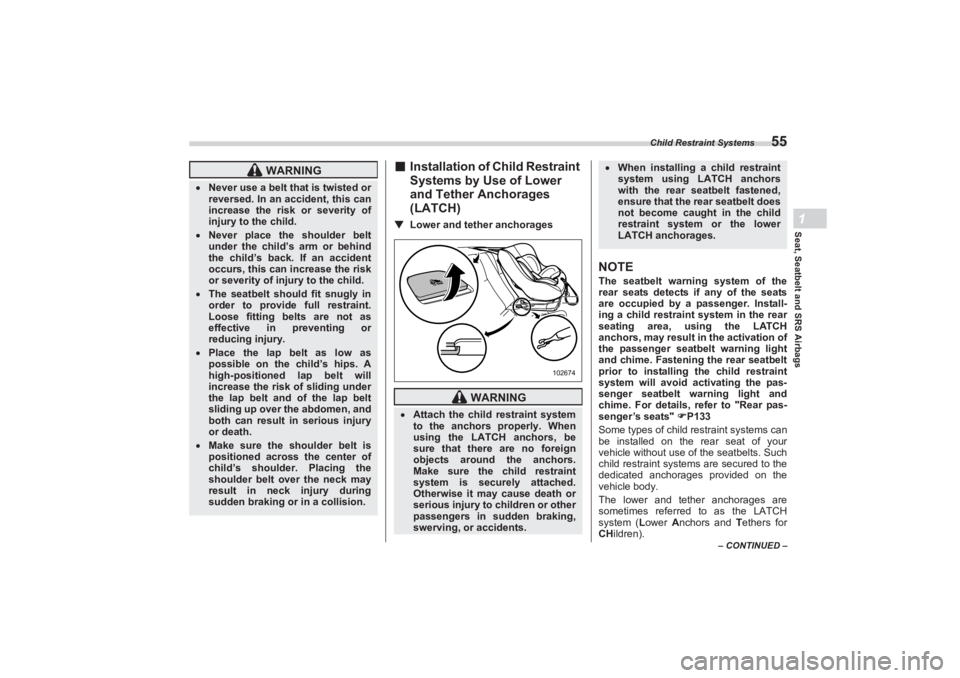
Child Restraint Systems
55
Seat, Seatbelt and SRS Airbags1
– CONTINUED –
■Installation of Child Restraint
Systems by Use of Lower
and Tether Anchorages
(LATCH)▼ Lower and tether anchorages
NOTEThe seatbelt warning system of the
rear seats detects if any of the seats
are occupied by a passenger. Install-
ing a child restraint system in the rear
seating area, using the LATCH
anchors, may result in the activation of
the passenger seatbelt warning light
and chime. Fastening the rear seatbelt
prior to installing the child restraint
system will avoid activating the pas-
senger seatbelt warning light and
chime. For details, refer to "Rear pas-
senger’s seats" P133
Some types of child restraint systems can
be installed on the rear seat of your
vehicle without use of the seatbelts. Such
child restraint systems are secured to the
dedicated anchorages provided on the
vehicle body.
The lower and tether anchorages are
sometimes referred to as the LATCH
system ( Lower Anchors and T ethers for
CHildren).
WARNING
Never use a belt that is twisted or
reversed. In an accident, this can
increase the risk or severity of
injury to the child. Never place the shoulder belt
under the child’s arm or behind
the child’s back. If an accident
occurs, this can increase the risk
or severity of injury to the child. The seatbelt should fit snugly in
order to provide full restraint.
Loose fitting belts are not as
effective in preventing or
reducing injury. Place the lap belt as low as
possible on the child’s hips. A
high-positioned lap belt will
increase the risk of sliding under
the lap belt and of the lap belt
sliding up over the abdomen, and
both can result in serious injury
or death. Make sure the shoulder belt is
positioned across the center of
child’s shoulder. Placing the
shoulder belt over the neck may
result in neck injury during
sudden braking or in a collision.
WARNING
Attach the child restraint system
to the anchors properly. When
using the LATCH anchors, be
sure that there are no foreign
objects around the anchors.
Make sure the child restraint
system is securely attached.
Otherwise it may cause death or
serious injury to children or other
passengers in sudden braking,
swerving, or accidents.
102674
When installing a child restraint
system using LATCH anchors
with the rear seatbelt fastened,
ensure that the rear seatbelt does
not become caught in the child
restraint system or the lower
LATCH anchorages.
BRZ_U.book 55 ページ 2022年3月29日 火曜日 午後3時59分
Page 71 of 432
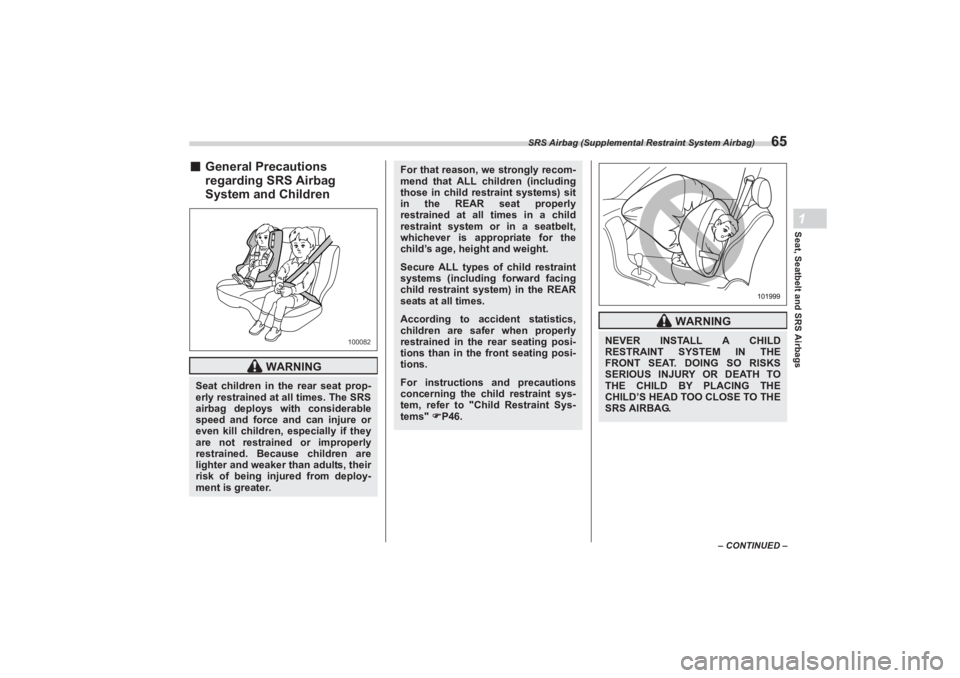
SRS Airbag (Supplemental Restraint System Airbag)
65
Seat, Seatbelt and SRS Airbags1
– CONTINUED –
■General Precautions
regarding SRS Airbag
System and Children
WARNING
Seat children in the rear seat prop-
erly restrained at all times. The SRS
airbag deploys with considerable
speed and force and can injure or
even kill children, especially if they
are not restrained or improperly
restrained. Because children are
lighter and weaker than adults, their
risk of being injured from deploy-
ment is greater.
100082
For that reason, we strongly recom-
mend that ALL children (including
those in child rest raint systems) sit
in the REAR seat properly
restrained at all times in a child
restraint system or in a seatbelt,
whichever is appropriate for the
child’s age, height and weight.Secure ALL types of child restraint
systems (including forward facing
child restraint system) in the REAR
seats at all times.According to accident statistics,
children are safer when properly
restrained in the rear seating posi-
tions than in the front seating posi-
tions.For instructions and precautions
concerning the child restraint sys-
tem, refer to "Ch ild Restraint Sys-
tems" P46.
WARNING
NEVER INSTALL A CHILD
RESTRAINT SYSTEM IN THE
FRONT SEAT. DOING SO RISKS
SERIOUS INJURY OR DEATH TO
THE CHILD BY PLACING THE
CHILD’S HEAD TOO CLOSE TO THE
SRS AIRBAG.
101999
BRZ_U.book 65 ページ 2022年3月29日 火曜日 午後3時59分